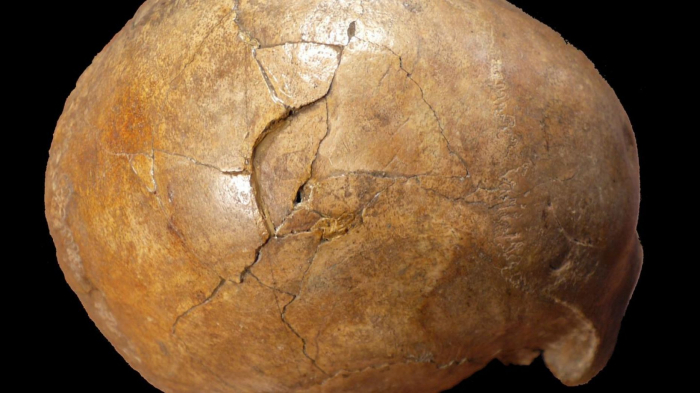The fossilized skull of the man who lived in the Paleolithic era was originally discovered in 1941 in a cave in South Transylvania, Romania.
While the skull has been extensively studied since its discovery, an international team of researchers has undertaken fresh analysis of the skull, specifically a large fracture. Experts have long debated whether the fracture was inflicted at the time of death or as a “postmortem event.”
Researchers led by the Eberhard Karls Universität Tübingen conducted a number of trauma simulations using 12 synthetic bone spheres. This involved testing scenarios such as falls from different heights, and single and double blows from rocks and bats. Computer simulations of the skull were also developed.
The scientists discovered two injuries that occurred at or near the time of death. One is a linear fracture at the skull’s base, the other is a depressed fracture on the right side of the cranial vault, which encases the brain.
“The simulations showed that these fractures strongly resemble the pattern of injury resulting from consecutive blows with a bat-like object; the positioning suggests the blow resulting in the depressed fracture came from a face-to-face confrontation, possibly with the bat in the perpetrator's left hand,” the researchers explain in a statement.
The fractures, they note, would have been fatal, indicating a violent death. "The Upper Paleolithic was a time of increasing cultural complexity and technological sophistication,” they say. “Our work shows that violent interpersonal behaviour and murder was also part of the behavioural repertoire of these early modern Europeans."
A paper on the research is published in the journal PLOS ONE.
The Paleolithic era, which is also known as the Old Stone Age, encompasses the period from the first known use of stone tools about 3 million years ago to about 10,000 years ago, according to LiveScience.
Stone Age discoveries have been grabbing plenty of attention recently. A student in Wales who was taking part in his first ever archaeological dig recently discovered an incredible ax dating back to the 'New Stone Age.'
In another project, scientists are searching for a lost Stone Age settlement in a prehistoric landscape at the bottom of the North Sea known as Doggerland.
Last year, archaeologists in Austria announced the discovery of a gruesome ‘kill site’ where Stone Age people slaughtered mammoths.
More about: #History
















































